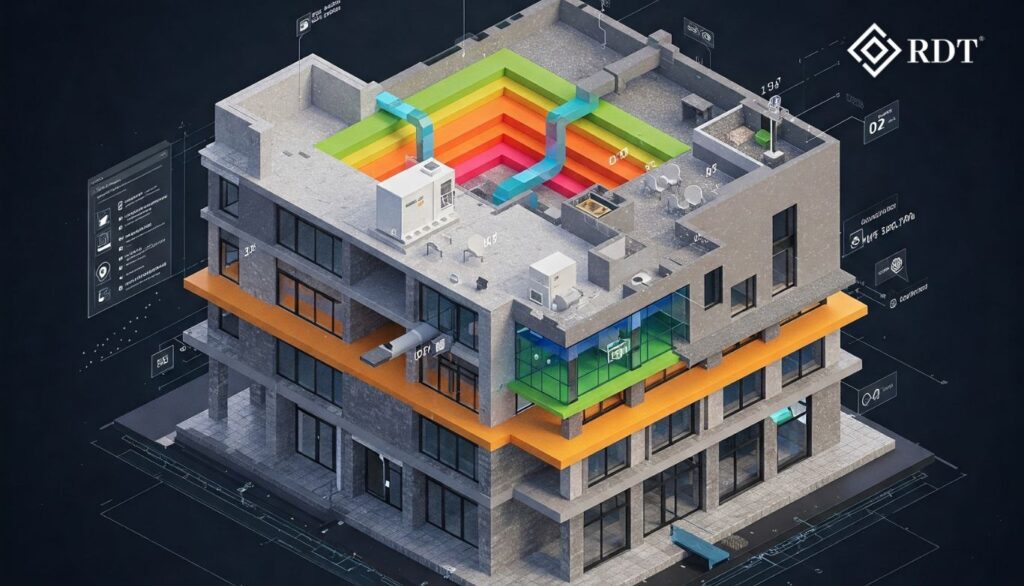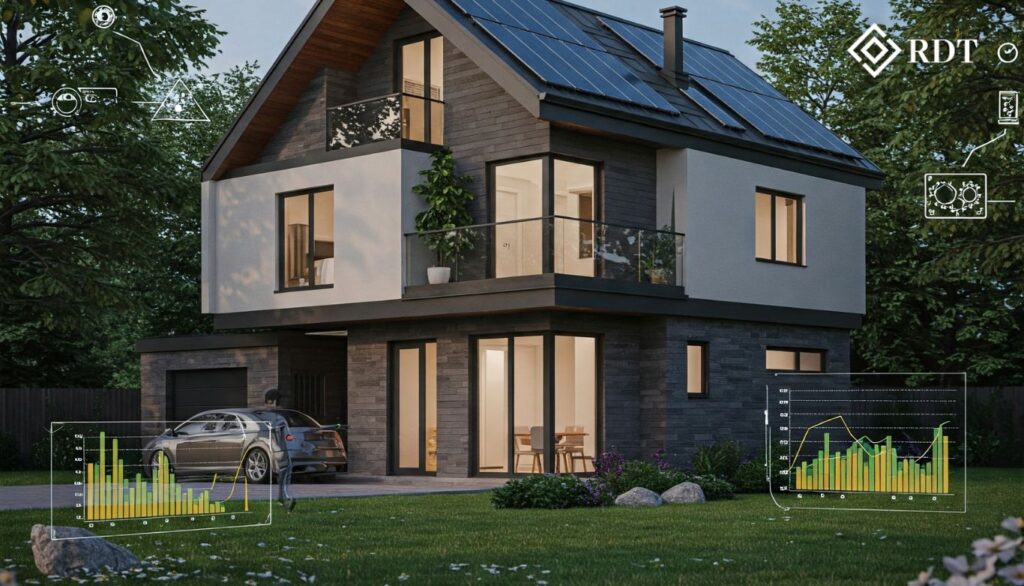The architecture, engineering, and construction (AEC) industry is experiencing a paradigm shift in residential design, driven by the adoption of Building Information Modeling (BIM). Unlike traditional 2D CAD methods, BIM offers a data-rich, collaborative environment that enhances design accuracy, cost management, and lifecycle performance. For enterprise-level architects and developers managing large-scale residential projects, BIM serves as a powerful tool to optimize operational efficiency, ensure sustainability, and enhance occupant comfort.
This blog delves into the technical applications of BIM in residential architecture, providing actionable insights on how we can offer cutting-edge BIM solutions for architects, contractors, and owners.
1. Multi-Dimensional BIM for End-to-End Design Optimization

While 3D modeling is the foundation of BIM, multi-dimensional BIM extends its capabilities across the entire project lifecycle:
- 4D BIM (Time Management): Simulations visualize construction sequences, enabling predictive clash detection and project scheduling optimization. Tools like Synchro 4D and Navisworks integrate with BIM models for granular timeline management.
- 5D BIM (Cost Estimation): Parametric modeling and AI-powered quantity takeoff tools generate precise material estimates, reducing budget variances. Through real-time cost simulations, stakeholders can predict financial impacts of design alterations.
- 6D BIM (Sustainability Analysis): Energy modeling platforms such as EnergyPlus or IES VE simulate HVAC loads, daylight penetration, and carbon emissions. AI-driven Life Cycle Assessment (LCA) tools predict operational and embodied carbon footprints.
- 7D BIM (Facility Management): By integrating with IoT sensors, 7D BIM creates a Digital Twin that monitors real-time energy consumption, tracks system performance, and automates predictive maintenance.
Example in Residential Projects
In large multi-residential complexes, architects can simulate construction phasing using 4D BIM, detect material procurement bottlenecks using 5D BIM, and generate accurate carbon impact reports with 6D BIM. After project completion, 7D BIM ensures proactive maintenance using sensor data.
2. AI-Driven Generative Design for Spatial Efficiency
Generative design algorithms use AI and computational power to produce optimized design alternatives. Architects input project constraints — such as building codes, site conditions, budget limitations, and energy efficiency goals — while the AI generates numerous design scenarios.
How It Works in BIM
- Evolutionary Algorithms: Platforms like Autodesk Forma or Dynamo for Revit apply machine learning models to iterate millions of design variations.
- Constraint-Based Optimization: Parameters like solar exposure, airflow patterns, and noise levels are input into the model. AI then ranks options based on the best performance outcomes.
- Occupant-Centric Space Planning: AI analyzes user behavior and proposes layouts that maximize daylight access, minimize HVAC loads, and enhance occupant well-being.
Real-World Application
For large-scale apartment complexes, AI-driven BIM models can suggest optimized layouts to maximize usable floor area while reducing corridor space. Architects gain insights into vertical transportation efficiency and egress planning using agent-based simulations.
3. Digital Twins for Post-Occupancy Monitoring and Optimization
A Digital Twin is a dynamic, real-time virtual replica of a physical building that integrates sensor data, BIM geometry, and performance analytics. In residential architecture, Digital Twins ensure ongoing operational efficiency and occupant satisfaction.
Key Functions of Digital Twins
- Performance Monitoring: Using data from HVAC systems, smart meters, and occupancy sensors, architects and facility managers can monitor real-time energy consumption. AI algorithms predict anomalies and optimize energy use.
- Predictive Maintenance: Integrated with 7D BIM, Digital Twins analyze equipment performance and forecast maintenance needs using predictive modeling.
- Occupant Experience Enhancement: AI-driven behavioral models analyze how residents interact with the space, recommending layout adjustments or automation settings to improve comfort.
Case Study: Smart Residential Community
A multi-tower residential complex using Digital Twin solutions can simulate and predict heating and cooling demands in real time. AI algorithms adjust HVAC loads based on occupancy data, reducing energy waste by up to 30%.
4. Computational Fluid Dynamics (CFD) for Indoor Environmental Quality (IEQ)

Maintaining indoor environmental quality (IEQ) is critical in residential buildings. Through BIM-integrated Computational Fluid Dynamics (CFD) simulations, architects model airflow, temperature distribution, and pollutant dispersion.
BIM-Integrated CFD Applications
- Air Quality Management: Predict airflow patterns to ensure adequate ventilation and minimize CO₂ buildup. Tools like ANSYS Fluent or SimScale integrate seamlessly with BIM platforms.
- Thermal Comfort Analysis: CFD models identify heat islands within a space, optimizing HVAC system placement for even temperature distribution.
- Smoke and Fire Simulation: Simulate smoke movement for enhanced fire safety and egress route planning in multi-unit residential projects.
By integrating BIM and CFD simulations, architects ensure enhanced thermal comfort, healthier indoor air quality, and effective fire safety strategies.
5. AI-Enhanced LCA for Sustainable Residential Architecture

Sustainability is no longer a luxury — it’s a necessity. Life Cycle Assessment (LCA) tools integrated within BIM platforms offer predictive insights into a building’s environmental impact across its entire lifecycle.
AI in LCA
- Material Selection Algorithms: AI algorithms evaluate material databases for low-carbon options, balancing factors like thermal performance, cost, and durability.
- Operational Carbon Monitoring: Post-construction, Digital Twins monitor operational energy use and recommend interventions to minimize carbon emissions.
- End-of-Life Scenario Analysis: BIM-integrated AI models predict deconstruction efficiencies, ensuring maximum material reuse and recycling.
Example in Residential High-Rises
A developer using LCA-integrated BIM can reduce embodied carbon by 25% by identifying alternative low-carbon concrete mixes. During operations, the AI predicts peak HVAC loads and suggests load-shedding strategies to minimize emissions.
Conclusion
Integrating BIM into residential architecture is no longer a question of “if” but “how.” From AI-driven generative design to real-time performance monitoring through Digital Twins, BIM serves as the foundation for creating hyper-efficient, sustainable residential spaces.
For architects and developers managing complex residential projects, leveraging multi-dimensional BIM and AI-powered insights enhances every aspect of the design, construction, and operational lifecycle. By embracing these cutting-edge technologies, industry leaders can achieve greater design precision, cost predictability, and operational resilience.





